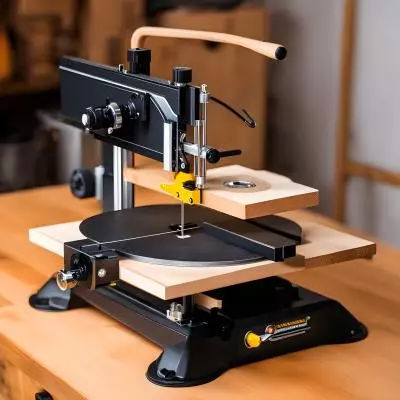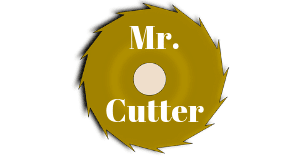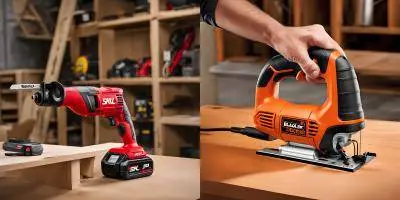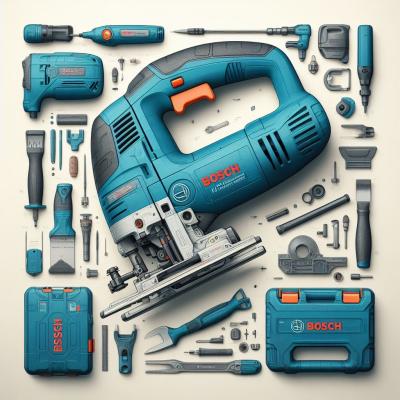Bandsaw vs Scroll Saw: A Comprehensive Guide to Choosing Your Next Woodworking Tool
Woodworking enthusiasts often debate the merits of two essential tools: the bandsaw and the scroll saw. Each offers unique capabilities, catering to different tasks and project intricacies. Understanding their distinct advantages and appropriate applications can significantly enhance the quality of one’s craft. This article aims to provide insights into the strengths and limitations of both, guiding users in making an informed choice.
I. Introduction
Woodworking, an art as ancient as human civilization itself, boasts a vast array of tools tailored for various tasks. From intricate carvings to robust furniture pieces, the choice of tool can either uplift or hinder an artisan’s vision.
A. Brief overview of woodworking tools
The woodworking realm presents a myriad of tools, each designed with precision and purpose. From hand tools like chisels and planes to power tools like routers and saws, the array is exhaustive. Yet, amidst this plethora, two tools often stand out due to their versatility and specificity: the bandsaw and the scroll saw.
B. Importance of choosing the right tool for the job
An impeccable finish is not just about skill but also about the harmony between the craftsman and his tools. Choosing the right tool ensures efficiency, safety, and the desired outcome. It’s akin to selecting the right brush for a painting – the strokes, depth, and effect depend heavily on this choice.
II. Bandsaw: An Overview
Known for its versatility and robustness, the bandsaw has been a staple in workshops for decades.

A. History and development of the Bandsaw
The bandsaw, which dates back to the 1800s, was a revolutionary tool designed to make consistent cuts using a blade in the form of a continuous band. Over the years, advancements in technology have enhanced its precision, power, and safety features.
B. Key features and functionalities
Bandsaws are characterized by their long, flexible blades that move around two or more wheels. This design allows for straight, uniform cuts, curves, and resawing. With varying blade widths and tooth configurations, bandsaws cater to intricate and heavy-duty tasks.
C. Common applications and projects suitable for bandsaws
From resawing lumber to crafting cabriole legs, bandsaws excel in a variety of tasks. They are ideal for cutting curves on thick lumber, ripping wood, and even creating veneers from large logs.
III. Scroll Saw: A Closer Look
When precision and delicacy are paramount, the scroll saw emerges as the go-to tool.

A. Origin and evolution of the scroll saw
The scroll saw’s history is nebulous, with its rudimentary forms appearing in the 1500s. Modern iterations, however, are electric-powered and are revered for their ability to produce intricate patterns and designs.
B. Distinctive characteristics
Scroll saws possess a thin blade that moves in an up-and-down motion. Their standout feature is the ability to start a cut from the interior of a workpiece without an external entry point, enabling intricate internal cutouts.
C. Typical uses and projects that benefit from a scroll saw
From detailed fretwork marquetry to crafting intricate jigsaw puzzles, the scroll saw is a favorite among artisans. Its precision makes it the preferred choice for projects demanding meticulous detailing.
IV. Comparing Bandsaw and Scroll Saw
While both saws have their unique strengths, understanding their similarities and differences can guide one’s choice.
A. Similarities between the two tools
Both the bandsaw and scroll saw are stationary tools designed for precision. They operate using blades and cater to specific woodworking needs, from cuts to designs.
B. Differences in design and operation
While bandsaws utilize a continuously looped blade, scroll saws employ a reciprocating blade. Bandsaws are more suited for thicker materials and can make deeper cuts, whereas scroll saws excel in delicate, detailed work on thinner materials.
C. Strengths and limitations of each tool
Bandsaws are powerhouses, ideal for resawing and handling thicker woods. Their limitation lies in extremely intricate patterns. Scroll saws, on the other hand, are masters of finesse, perfect for delicate designs but are not intended for heavy-duty tasks.
V. Making the Right Choice
With myriad options, how does one decide between the bandsaw and the scroll saw?
A. Considerations for beginners
For novices, it’s crucial to understand the nature of their projects. Those leaning towards general woodworking might find the bandsaw more useful. However, for detailed artwork, a scroll saw is indispensable.
B. Factors to consider based on project requirements
Evaluate the material thickness, the intricacy of the design, and the desired finish. While bandsaws handle bulk and depth, scroll saws manage finesse and detail.
C. Cost implications and value for money
While bandsaws generally are pricier due to their versatility and power, scroll saws are more affordable. Consider the long-term usage, potential projects, and available budget when making a choice.
VI. FAQs
Q: What is the primary difference between a bandsaw and a scroll saw?
A: A bandsaw utilizes a continuously looped blade and is ideal for making straight cuts, resawing, and handling thicker materials. In contrast, a scroll saw employs a thin, reciprocating blade and is designed for intricate cuts, detailing, and working on thinner materials.
Q: What is the disadvantage of a scroll saw?
A: The primary disadvantage of a scroll saw is its limitation in handling thicker materials. It is primarily designed for intricate detailing, so it is not suitable for heavy-duty tasks or cutting through very thick lumber.
Q: How is a bandsaw blade different from a scroll saw blade?
A: A bandsaw blade is a continuous loop that revolves around two or more wheels, allowing for straight and curved cuts. A scroll saw blade is thin, straight, and moves in an up-and-down reciprocating motion, enabling intricate internal cutouts without an external entry point.
Q: Do I really need a scroll saw?
A: It depends on the nature of your projects. If you often work on intricate designs, delicate cutouts, marquetry, or fretwork, a scroll saw would be invaluable. However, for general woodworking tasks, other tools might be more suitable.
Q: Why use a scroll saw over other saws for detailing?
A: A scroll saw allows for extreme precision and can make internal cuts without requiring an entry point. Its thin blade and reciprocating motion make it perfect for intricate designs and delicate cutouts that other saws might struggle with.
Q: Can a bandsaw replace a scroll saw, or vice versa?
A: Not entirely. While there is some overlap in their functionalities, each saw excels in specific areas. Bandsaws are versatile and can handle thicker materials, but they might offer a different level of precision for intricate designs than scroll saws. Conversely, a scroll saw is unmatched in detailing but needs to be more suitable for heavy-duty tasks.
Q: Are scroll saws safe for beginners?
A: Yes, scroll saws are among the safer power tools due to their design and slower cutting speed. However, as with any tool, it’s essential to understand its operation, follow safety guidelines, and practice caution during use.
VII. Conclusion
A comprehensive understanding of the bandsaw and scroll saw reveals that both tools have their unique strengths and purposes.
A. Recap of key points discussed
From their historical origins to their modern functionalities, the bandsaw and scroll saw have carved their niches in the woodworking world. While the bandsaw is revered for its versatility and ability to handle bulk, the scroll saw stands out for its precision and finesse.
B. Importance of tool versatility in woodworking
As in any craft, the brilliance of the final product often lies in the choice of tools. Selecting the right tool not only ensures efficiency but also elevates the quality of work, making it crucial for woodworkers to understand the strengths of their arsenal.
C. Encouragement for continual learning and practice
The world of woodworking is vast and ever-evolving. By continually learning, experimenting, and practicing, artisans can harness the full potential of their tools, bringing their visions to life.
VIII. Suggested Readings
The world of woodworking offers a plethora of resources. Here are five books that delve deeper into the art, the tools, and the techniques:
- “The Bandsaw Book” by Lonnie Bird: An exhaustive guide to the bandsaw, its mechanics, and its uses. Bird elaborates on techniques, tips, and projects to make the most of this versatile tool.
- “Scroll Saw Workbook” by Charles Dearing: Ideal for beginners and experts alike, this workbook provides step-by-step instructions for creating intricate scroll saw patterns, ensuring mastery over the tool.
- “The Complete Manual of Woodworking” by Albert Jackson, David Day, and Simon Jennings: A comprehensive guide that spans tools, materials, and techniques. It’s a must-have for every woodworking enthusiast.
- “The Essential Woodworker” by Robert Wearing: Wearing dives into skills, tools, and techniques, making it a valuable resource for both novices and seasoned woodworkers.
- “The Woodworker’s Bible” by Andy Rae: Covering everything from setting up a workshop to the intricacies of joinery, Rae’s book serves as a comprehensive guide for all things woodworking.
Whether you’re a novice just dipping your toes or a seasoned craftsman, these readings promise to enhance your understanding and passion for the art of woodworking.







